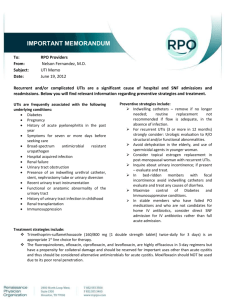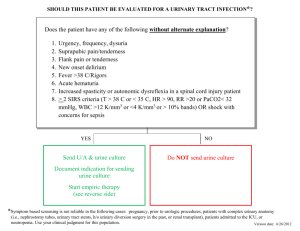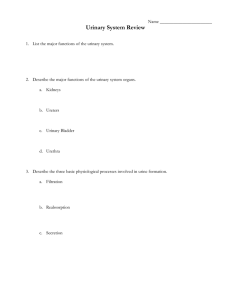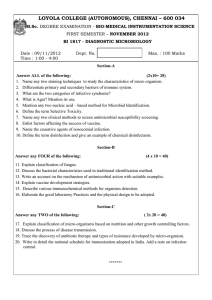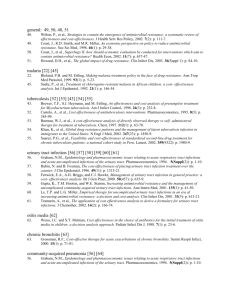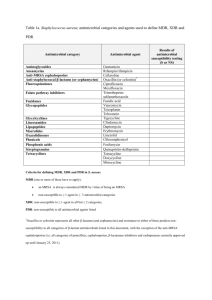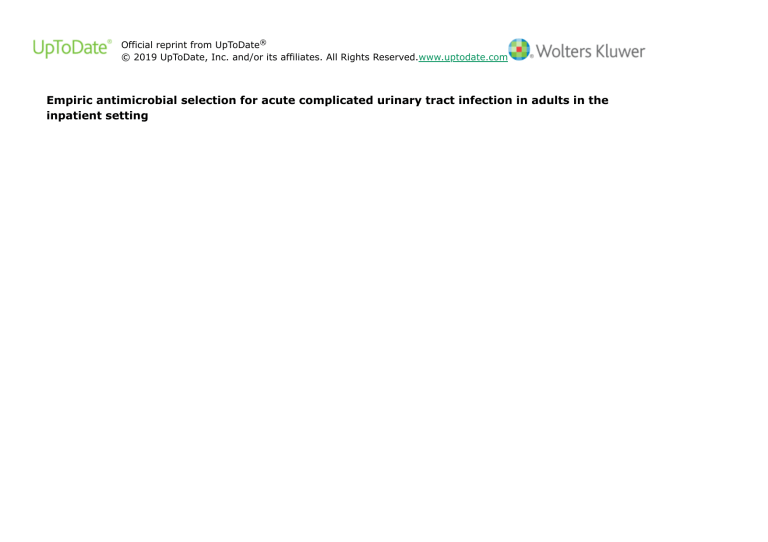
Official reprint from UpToDate® © 2019 UpToDate, Inc. and/or its affiliates. All Rights Reserved.www.uptodate.com Empiric antimicrobial selection for acute complicated urinary tract infection in adults in the inpatient setting This algorithm reflects our approach to the selection of empiric antimicrobial therapy for patients hospitalized (or expected to be hospitalized) with an acute complicated UTI (ie, cystitis with signs or symptoms of infection extending beyond the bladder or pyelonephritis). Ultimately, the selection of antimicrobial therapy should be individualized based on severity of illness, individual and community risk factors for resistant pathogens, and specific host factors. The decision to hospitalize a patient is usually clear in the setting of critical illness or sepsis. Otherwise, general indications for inpatient management include persistently high fever (eg, >101°F/>38.4°C) or pain, marked debility, inability to maintain oral hydration or take oral medications, suspected urinary tract obstruction, and concerns regarding adherence to therapy. If outpatient management is anticipated following therapy in the emergency department, refer to other UpToDate content on antimicrobial therapy selection for the outpatient setting. In addition to antimicrobial therapy, the possibility of urinary obstruction should be considered and managed, if identified. Patients who have anatomical or functional urinary tract abnormalities (including neurogenic bladder, indwelling bladder catheters, nephrostomy tubes, ureteral stents) may warrant additional management, such as more frequent catheterization to improve urinary flow, exchange of a catheter, and/or urologic or gynecologic consultation. Doses listed are for patients with normal renal function and may require adjustment in the setting of renal impairment. MDR: multidrug-resistant; ESBL: extended-spectrum beta-lactamase; MRSA: methicillin-resistant Staphylococcus aureus; IV: intravenous; TMP-SMX: trimethoprim-sulfamethoxazole; UTI: urinary tract infection; VRE: vancomycin-resistant enterococci. * We consider individuals who have typical cystitis symptoms only, without fever or other systemic symptoms, to have acute simple cystitis and manage them differently. The temperature threshold used to determine whether to treat a patient as simple cystitis versus complicated UTI is not well defined and should take into account baseline temperature, other potential contributors to an elevated temperature, and the risk of poor outcomes should empiric antimicrobial therapy be inappropriate. Refer to other UpToDate content on our approach to categorization of UTI. ¶ The possibility of prostatitis should also be considered in men. Δ Patients with suspected or documented sepsis typically present with hypotension, tachycardia, fever, and leukocytosis. As severity worsens, signs of shock (eg, cool skin and cyanosis) and organ dysfunction (eg, oliguria, acute kidney injury, altered mental status) develop. ◊ Features that should raise suspicion for urinary tract obstruction include a decline in the renal function below baseline or a decline in urine output. § An MDR isolate is nonsusceptible to at least one agent in three or more antimicrobial classes; this includes ESBL-producing isolates. ¥ This includes a single antimicrobial dose given for prophylaxis prior to prostate procedures. ‡ In locations where the community prevalence of MDR organisms is low, standard spectrum regimens may be appropriate. † Advanced cephalosporin or carbapenem combinations with beta-lactamase inhibitors and the advanced aminoglycoside plazomicin also have activity against some ESBL-producing and, in some cases, MDR Pseudomonas aeruginosa isolates and are effective for acute complicated UTI; however, these should only be used in select cases of highly resistant infections. If carbapenem resistance is suspected based on prior susceptibility testing results, an infectious diseases consult should be obtained. ** The choice among these agents depends on susceptibility of prior urinary isolates, patient circumstances (allergy or expected tolerability, history of recent antimicrobial use), local community resistance prevalence (if known), drug toxicity and interactions, availability, and cost. If Enterococcus or Staphyloccus species are suspected (eg, because of prior urinary isolates or gram-positive cocci on a current urine Gram stain), piperacillin-tazobactam is preferred because it has activity against these organisms. If drug-resistant gram-positive organisms are suspected because of previous urinary isolates or other risk factors, vancomycin (for MRSA) or linezolid or daptomycin (for VRE) should be added. If there is a risk of P. aeruginosa (eg, because of growth on a urine culture in the past six months or febrile neutropenia, the higher dose of piperacillin-tazobactam or a fluoroquinolone should be chosen. Other appropriate antipseudomonal agents include cefepime and ceftazidime. ¶¶ In many cases, broad-spectrum antimicrobial regimens can be replaced by a more narrow-spectrum agent. Appropriate oral agents to treat complicated UTI include levofloxacin, ciprofloxacin, and TMP-SMX. Beta-lactams are appropriate if susceptibility is documented and other agents are not feasible. Graphic 115994 Version 7.0
